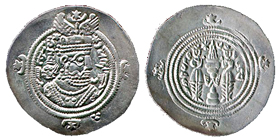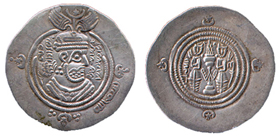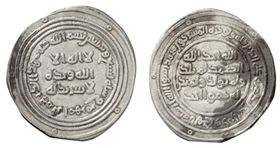|
The Origins of Islam  A Pre-Islamic coin of Persia from 626 AD showing the face of a King and a Zoroastrian Fire Temple.  A typical Islamic coin from 663 AD with the same Pre-Islamic iconography as above and makes no mention of Muhammad or Islam.  Abd al-Malik was the first Arab Caliph to finally mint recognizable Islamic coins. This coin from 698 AD removes the Zoroastrian Fire Temple and the human imagery (forbidden in Orthodox Islam) and replaces them with an actual sura from the Quran (112). However Abu Bakr died in 634 AD, and leadership passed to the next Caliph: Umar, another early convert to Islam who had spent 17 years at Muhammad's side. During the Caliphate of Umar, Muslim armies conquered almost the entire Middle East, including the Levant, Egypt, and much of Persia, the rest of Persia was conquered under the reigns of the two subsequent Rashidun Caliphs (Uttman & Ali).(see map 4 - 661 AD) One of the strangest peculiarities in the traditional account of the Rise of Islam is that none of the so-called "Rashidun" (rightly-guided) Caliphs ever mentioned the name of Muhammad or anything to do with Islam on any of their inscriptions or coinage. This has led scholars The Rashidun Caliphate came to an end in a civil war, from 661 AD a new dynasty emerged from this civil war known as the Umayyad Caliphate. None of these men had ever been close companions of Muhammad. The Conquest of the Maghreb During the Umayyad Caliphate, the pace of conquests began to slow down. When the Muslim armies reached the Maghreb, what Arabs call Northwest Africa, they were met with stiff resistance. At this time, control of Northwest Africa was divided amongst the Byzantines, who controlled the coastal area around the city of Carthage, and the native Berber peoples, who controlled the interior and the coastal area of Morocco. (See map 5 - 670 AD) The City of Carthage fell quite easily to the Muslims, who then moved on to wage war against the Berbers. Berber resistance to the Muslim conquest focused around a Berber Queen named Kahina, she led the Berbers in a number of successful battles against the Muslims. In the meantime, the Byzantine Emperor Leontius sent his navy to recapture Carthage from the Muslims in a stunning surprise attack. The Muslims were forced to retreat to Kairouan and regroup, in 698 AD they besieged Carthage for a second time and captured the city. As punishment for the city's stiff resistance, the Muslims destroyed Carthage for the second time in it's history, just as the Romans had done in 146 BC. With Carthage finally destroyed, the Muslims were able to turn their attention back to the Berber resistance, in 702 AD, the Muslims defeated Kahina once and for all at the Battle of Tabarka. (See map 6 - 710 AD) The Invasion of Europe Once all of North Africa was under the rule of the Islamic Caliphate, the Muslim Arabs wasted no time in crossing the Straits of Gibraltar and invading Europe. Visigothic Spain was easily overrun in just a few years, but the Arabs were stopped by the Franks at the battle of Tours in 733 AD. Thus most of Europe was saved from Muslim rule and would to this day remain Christian. (See map 7 - 733 AD) Aftermath Nevertheless, the expansion of Islam was astounding. In just 100 years since Muhammad first claimed prophethood, Islam had by force of arms, conquered all of Arabia and then expanded out and conquered as far west as Spain and as far east as Afghanistan. The Islamic Caliphate had become the largest empire the world had yet known, controlling some of the most important centers of civilization. Of the 5 Christian Patriarchates (the 5 great urban centers of Christianity in the 6th-7th centuries AD), 3 of them now fell under Islamic rule (Jerusalem, Alexandria, and Antioch), with only Rome and Constantinople still under Christian rule. From this point on, much of Mediterranean history would be characterized by the struggles between the Christian and Islamic faiths, the Christians holding the north side of the Mediterranean and the Muslims the south side. The battlegrounds were to be Spain, Jerusalem, Constantinople, and the islands caught in the middle. Comparing the Rise of Islam to the Rise of Christianity It is tempting to compare the astounding spread of Christianity with that of Islam. Both faiths began as the teachings of a single man and both witnessed exponential, almost miraculous growth in just a few centuries. However the method by which the two faiths spread could not have been more different. For the first three centuries AD, Christianity had spread by peaceful conversion. Then once it became adopted as the official religion of the Roman Empire in the 4th Century AD, Christians had sufficient power to dominate, intimidate, and supress other religions. The followers of Islam on the other hand used military force from the very beginning of their history, even during the life of Muhammad himself. Towns were brought under Islamic rule by conquest, and their main churches and temples were usually converted to mosques. Christians and Jews were treated a little fairer than followers of other religions as they were considered Abrahamic Faiths and would be tolerated as long as they paid the Jizya, a special tax that Jews and Christians had to pay the Islamic state in order to practice their religion. In the first few centuries of Islamic rule, there is no evidence of forced conversion of Christians or Jews, nevertheless there were considerable economic and social pressures to convert to the ruling religion. Think you know all about the Rise of Islam? Test yourself on our quick online quiz *Some scholars question how important Mecca could have been during the Rise of Islam. Mecca is located in a barren valley devoid of agriculture and not on any plausible ancient trade route because most trade between India and the Mediterranean was conducted by sea. Furthermore, there are no clear references to a city called Mecca in any ancient writings prior to Islam. See P. Crone - Meccan Trade and the Rise of Islam**Though there is an older tradition that mentions that Muhammad was still alive during the Muslim Invasion of Palestine. For a comprehensive analysis of this tradition, see S.J. Shoemaker - Death of a Prophet |
Recommended Reading:
|



